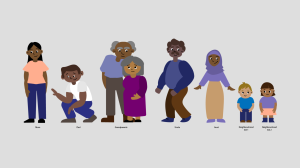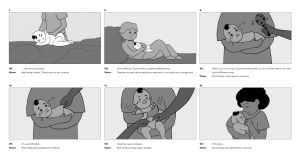
Interview with our animator Charmaine
By Mia Elliott
Q – Hey Charmaine, tell me a little bit about your animation project!
A – Hey! I’ve been working on this animation project for roughly a year now… actually since my very first day here. So it’s kind of a sentimental one. It’s for one of our NFP clients, STARTTS (NSW Service for the Treatment and Rehabilitation of Torture and Trauma Survivors)… basically a 6 part educational animation video series that shows new parents ways to engage with their children through things like reading and playing. The target audience is specifically refugees from diverse cultural backgrounds. The videos run through each stage of a baby’s development (from 0-4 months, to 25-36 months), and reveal what to expect along the way.
Q – This has been a fairly long-term animation project, run me through your process?
A – We started off chatting with the client and seeing what the project entailed. Then we made style frames, which are basically a couple frames to show the client what the final animation is going to look like visually. Because these videos are about children, we went for a softer, pastel colour scheme. The designs use block colours and appear very flat, which is good for keeping the visuals as simple and digestible as possible. After the client approved these, we moved on to storyboarding, which is a longer process. It’s kind of like making a comic book, attaching an image to each part of the script line. After a few rounds of feedback from STARTTS, we finalised these and started animating on AfterEffects! Next step was putting our creations into Premiere. This is where we add sound and final adjustments… Then we send it off to the client!

Styleframing

Storyboarding
Q – A big part of this project was providing different translations…
A – Yes! So these videos are for people who don’t have access to a lot of in-language materials. We brought translators (organised by STARTTS) into the recording studio and recorded them reading each line. It was really great meeting all of these people from such varied backgrounds. So far we have Ezidi, Assyrian, Hazarigi, Karen, Farsi and Rohingha translations… and counting! This actual process is timely – after recording, you go into Premiere and manually change each English line to its translation. Because of the language barrier, we used codes to match up each line in Premiere. Then subtitles are added, plus any English words which appear within the animation itself are changed to their translations. Also, sometimes a translation is longer or shorter than the original clip time. For example, Farsi is spoken much longer than English, whereas Ezidi is roughly the same. This means altering the video itself to align with speaking time. Farsi is also written from right-to-left, so that was a cool, different subtitle process (also meant changing some of the animation itself e.g. the direction of a hand opening a book had to be flipped). For a while this actually messed my brain up – Akrom wrote a question mark and I fully thought it was backwards.
Q – What was your biggest challenge along the way?
A – Honestly, translating is hard because it gets monotonous. It’s also impossible to self-check – you need people who can speak the language to approve the work themselves. So the process can get tricky, but we do a lot of this here so nothing is impossible!
Q – Okay, understandable… Now what was your favourite part of the process?
A – In general, it was pretty rewarding to create something that benefits new parents and their children! I also love character animation. After working with storyboards for so long, actually seeing your design move is really fun! I am also really lucky to have great coworkers here that gave me really helpful feedback throughout the process (thanks Akrom + Jonty).
Q – What do you think makes a great educational animation?
A – Scripting is really really important. How you word things is crucial. Sometimes scripts can get overwritten. You have to remember that with animation, you’ll have a visual component to it, so don’t say everything, you can show it as well. For this project especially, it was important to keep communication really simple. We wanted a video that is pleasurable to watch. This is where graphics and design come in hand, because if a video looks good, a viewer is much more likely to stay engaged.
VIEW ONE OF THE BABY MAP ANIMATIONS HERE:






